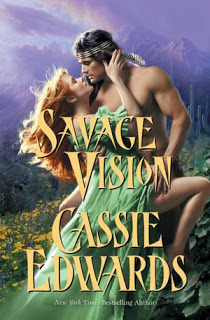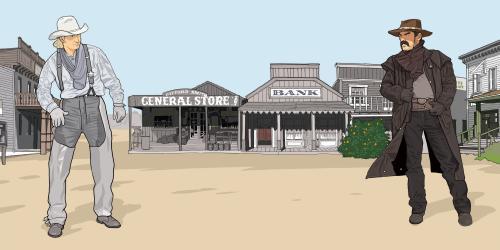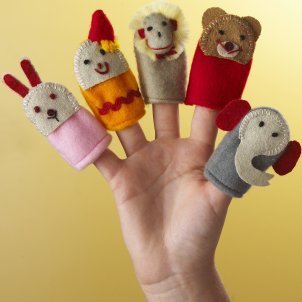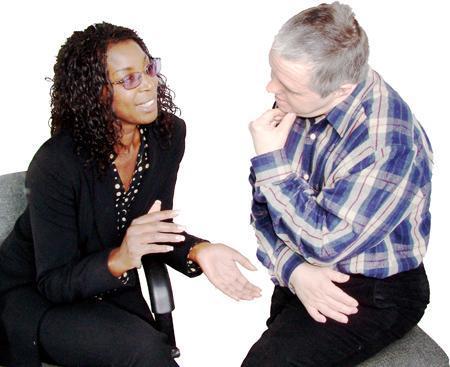S.B. Stewart-Laing's Blog, page 18
July 3, 2013
Taming the Exotic: Sexytimes With The Other, Part II (Mildly NSFW)
 The counterpart to the 'let's go on a meaningless sexy adventure' portrayal of a WASP-y protagonist and an Other love interest is the 'Power of Love' story, in which the exotic lover is tamed and assimilated by the protagonist, and essentially made into a socially acceptable partner. Older works are likely to star a European or Euro-American man and an Other woman, but there's an abundance of stories, particularly romance novels, with the gender roles reversed (see the cover at the right... there were pages and pages of them on Google search, and that was just the Native American/white pairings!)
The counterpart to the 'let's go on a meaningless sexy adventure' portrayal of a WASP-y protagonist and an Other love interest is the 'Power of Love' story, in which the exotic lover is tamed and assimilated by the protagonist, and essentially made into a socially acceptable partner. Older works are likely to star a European or Euro-American man and an Other woman, but there's an abundance of stories, particularly romance novels, with the gender roles reversed (see the cover at the right... there were pages and pages of them on Google search, and that was just the Native American/white pairings!)This trope has a similar yuck factor to the one I discussed on Monday, namely that it implies the culture/religion/etc of the Other character is inferior, and something that needs to be 'fixed' before they can be considered an appropriate partner for the protagonist. The added bonus is the implication that the WASP character is doing their love interest a favour by erasing their cultural heritage. (This also pops up in the inter-class variant, where the wealthy character teaches the poor character about expensive clothes, etc.; in older works the love interest converting to the 'right' religion-- typically Christianity-- crops up as well).
This gets presented, typically, as a happy outcome, since most of the conflict in this scenario stems from social disapproval of the relationship, and not from conflict within the couple based on individual personalities or incompatible cultural beliefs and customs.
I'm not in the least against writing stories where the main character(s) find love across racial, socio-economic, cultural or religious lines. There's lots of stories there to explore. Just let your characters be people instead of relying on the two established templates for romancing the Other.
Published on July 03, 2013 02:52
July 1, 2013
'Raped by Santa Claus': Sexytimes With The Other, Part I
 In every genre from Serious Literature to paperback romance novels, we have characters who fit the middle-class-WASP-default mold getting it on with people who are coded as the Other in the context of the story. Whether the divide is about socioeconomic class, ethnicity, race, or religion, there are some tropes which play out again and again. The first, which we'll address today, is the 'walk on the wild side', where the focus is on the emphasis is on the WASP character having an adventurous fling, often before settling down with a more socially acceptable partner.
In every genre from Serious Literature to paperback romance novels, we have characters who fit the middle-class-WASP-default mold getting it on with people who are coded as the Other in the context of the story. Whether the divide is about socioeconomic class, ethnicity, race, or religion, there are some tropes which play out again and again. The first, which we'll address today, is the 'walk on the wild side', where the focus is on the emphasis is on the WASP character having an adventurous fling, often before settling down with a more socially acceptable partner.The 'wild side' dynamic usually (but not always) involves a white/WASP women and a Other man. Incidentally, the title of the post is a reference to the 'you were raped by Santa Claus' scene in Invisible Man, which portrays one of these encounters from the point of view of the man being used as the 'exotic' adventure. The trope was clearly alive and well when Ellison wrote his novel, and shows zero signs of slowing down. Native American men seem to be a favorite, with black and racially-ambiguous South Americans as the runners-up; when the WASP character is male, the discarded love interest is often of some Asian ethnicity (and because I haven't picked on Scott for several weeks, I'd like to point out that Waverly features a rare European vs Celtic example).
What distinguishes the fictional dynamic is the fact the Other character exists to be discarded-- they symbolise the protagonist sowing their wild oats and generally being irresponsible, and ultimately serve as a foil for the 'real' love interest, who invariably represents society's vision of a more appropriate partner. The key feature is this can't have anything to with the Other character's behaviour (except when that behaviour is indicative of their social status, ethnicity, etc)-- if there's a genuine personality clash that tanks the relationship, or a sincere effort on both sides to make things work (in which case you have a Tragic Interracial Romance, which is a post for another day), or the Other character is a jerk and gets rightfully dumped (which, depending on the characters, might be another can o' worms), it isn't this trope.
There's a lot of problems to be unpacked here, but the two main issues are these: first and foremost, the Other character does not get a chance to develop as a character. They exist as a shell to serve the interests of the protagonist, and lack any motives of their own, by extension suggesting that the Other cannot exist on their own terms, but must be a reflection of the 'normal' character. They are never considered as a human being who might make a good life partner, but rather less than human-- a pet that can be taken to the pound to make room for a human infant. Which brings us to the second problem-- the whole 'adventure and discard' model almost always involves dissing the Other character's culture/religion/socioecomic background, using this apparent inferiority as a reason they aren't viable life partner material.
So what if the two characters give it slightly more of a genuine effort? You're not out of the woods yet. Stay tuned for Part II.
Published on July 01, 2013 06:08
June 28, 2013
Describing the Insider and the Other
 In one of her reviews of the Silver Phoenix and Fury of the Phoenix, the blogmistress of Requires Only Hate astutely points out that author Cindy Pon falls into a common trap of writing about an environment unlike one's own: mixing up the author's 'default' and 'other' with the 'default' and 'other' which would be natural for the characters. This disconnect between the character's world and the author's sense of what is 'normal' usually jars the reader out of the viewpoint and the story, as well as creating an uncomfortable dynamic.
In one of her reviews of the Silver Phoenix and Fury of the Phoenix, the blogmistress of Requires Only Hate astutely points out that author Cindy Pon falls into a common trap of writing about an environment unlike one's own: mixing up the author's 'default' and 'other' with the 'default' and 'other' which would be natural for the characters. This disconnect between the character's world and the author's sense of what is 'normal' usually jars the reader out of the viewpoint and the story, as well as creating an uncomfortable dynamic.It's hard to get out of our own 'default' settings as far as what counts as 'typical' behaviour, appearance, and cultural standards, since we don't often think critically about them. However, it's imperative we look at the world through the eyes of our characters, particularly as we describe people and settings through their point of view.
Revealing through descriptive language choices what your characters take for granted and what your characters find unusual is a subtle and effective technique for worldbuilding. Without a single info-dump, you can share a lot of the physical and social environment of your setting, and give the reader an insider's view of the world.
Published on June 28, 2013 02:31
June 26, 2013
It's Okay to Be Gray: Moral Ambiguity in Historical Fiction
 The human experience is rarely tidy. We do bad things for good reasons, we do good things for morally questionable reasons, we face ethically sticky situations with no right answers. Ambiguity also bothers us-- as a species, we like categories and easy answers. So it's tempting, when writing historical fiction (or alternate history, etc) to shoehorn people into 'good guy' and 'bad guy' roles.
The human experience is rarely tidy. We do bad things for good reasons, we do good things for morally questionable reasons, we face ethically sticky situations with no right answers. Ambiguity also bothers us-- as a species, we like categories and easy answers. So it's tempting, when writing historical fiction (or alternate history, etc) to shoehorn people into 'good guy' and 'bad guy' roles.In reality, of course, can get a bit more complicated. First of all, life doesn't offer a lot of clear-cut right and wrong answers. Throughout history, people with good intentions have caused massive harm, and people with selfish or destructive intentions have made valuable contributions to history. These contradictions between intent and outcome force us to separate the person, the goal, and the action. We can't place these people or their role in history into neat moral categories.
There are also many, many historical examples of people facing impossible choices, where either outcome will cause suffering, and the only thing to do is pick the 'least awful' option. These are situations in which even the wisest and most compassionate characters can look callous. There's no way to make these characters into simple heroes without glossing over the tragedy of the choices they faced and the decisions they made.
In the end, it's often best to simply show what unfolded-- what people knew, what they intended, and what finally resulted. We don't need someone to be a squeaky-clean hero in order to empathise, and often, a flawed, realistic, complicated person is easier to like. Besides, the twists and turns and ambiguities of real-life historical events are much more thrilling than another sanitised good-vs-evil throwdown.
Published on June 26, 2013 02:41
June 19, 2013
Main Characters Screw Up & That's OK
As the ever-insightful Tiger Grey pointed out in a recent comment, it's common for readers to see the main characters-- especially first-person narrators-- as extensions of the author's views, without taking cues from context in the story (especially context which indicates the main character might be incorrect). As spot-on as this observation is, I do wonder if part of that behaviour is due to the fact many authors have a massive aversion to letting their main characters be wrong in the first place.
Part of this may be due to not wanting to watch one's characters screw up, because there's a cringe element to seeing them walk into a trap or create series of avoidable problems for themselves. Even though they're not real, and even though we're the ones dumping them into troublesome situations on purpose (bwahahaha!), it's tempting to use our omniscient author skills to make everything okay.
Because first of all, characters who never make a mistake are about as entertaining as a sleeping pet rock. We know they're not going to get it wrong, and thus they're never in any physical or psychological danger, which kills the suspense. Even in genres where we expect the hero to triumph, we know that they might make an almost-fatal mistake, like identifying the wrong person as the mole or miscalculating how fast the were-iguana army can reach their fortress.
Second, characters should make mistakes do so because they have flaws and shortcomings, and those imperfections are what make them relatable. We can't really see anything of ourselves in a character whose perception is always perfectly in tune with objective reality, because that's not how we experience the world. Characters with limited perception, limited knowledge*, and personality faults which cause them trouble are human-like and thus able to inspire empathy (or at least fascination).
Part of this may be due to not wanting to watch one's characters screw up, because there's a cringe element to seeing them walk into a trap or create series of avoidable problems for themselves. Even though they're not real, and even though we're the ones dumping them into troublesome situations on purpose (bwahahaha!), it's tempting to use our omniscient author skills to make everything okay.
Because first of all, characters who never make a mistake are about as entertaining as a sleeping pet rock. We know they're not going to get it wrong, and thus they're never in any physical or psychological danger, which kills the suspense. Even in genres where we expect the hero to triumph, we know that they might make an almost-fatal mistake, like identifying the wrong person as the mole or miscalculating how fast the were-iguana army can reach their fortress.
Second, characters should make mistakes do so because they have flaws and shortcomings, and those imperfections are what make them relatable. We can't really see anything of ourselves in a character whose perception is always perfectly in tune with objective reality, because that's not how we experience the world. Characters with limited perception, limited knowledge*, and personality faults which cause them trouble are human-like and thus able to inspire empathy (or at least fascination).
Published on June 19, 2013 02:20
June 17, 2013
Don't Try This At Home: On Portrayal vs. Endorsement
 As I alluded to in a previous post, I have a huge pet peeve about readers who can't-- or won't-- separate the views of an unreliable first-person narrator from the views or intention of the author (for example, calling a story sexist because the narrator is a huge chauvinist, even though other facts in the narrative show that he's clearly wrong). In the same vein, many people--both authors and readers-- seem to conflate portraying something in a story with endorsing that opinion or behaviour.
As I alluded to in a previous post, I have a huge pet peeve about readers who can't-- or won't-- separate the views of an unreliable first-person narrator from the views or intention of the author (for example, calling a story sexist because the narrator is a huge chauvinist, even though other facts in the narrative show that he's clearly wrong). In the same vein, many people--both authors and readers-- seem to conflate portraying something in a story with endorsing that opinion or behaviour.Characters-- at least those who aren't a spectacular Mary Sue or spectacularly dull-- make mistakes. This means your character will do and say stuff that makes the reader gasp or cringe or facepalm, with the understanding that the character is definitely wrong (even if no one immediately calls them out on the problem due to the nature of the story or environment or characters around them). You are telling a story about a set of unique and flawed characters, not writing a guide to etiquette or morality.
Furthermore, whole societies have systemic problems which will be reflected in the characters' behaviour. This can be particularly jarring in historical fiction, because the problems of the era are often different than those of our own society, to which we're somewhat desensitised. Given that environment, even the sympathetic characters are likely to express views which will be repellent to modern readers. The characters in the Forgotten Gods series toss ethnic and sectarian slurs around constantly, as well as doing any number of questionable things in the pursuit of doing what they think is right. In real life, Michael and I have banned people from our respective homes for saying stuff like that, and we assume our readers will see the negative impact characters' bigoted views, and take it as social criticism rather than a suggestion for how to make small talk.
Published on June 17, 2013 02:18
June 14, 2013
A Cast of Many Voices
 One of the things I enjoy about writing the Forgotten Gods series is that we have such a varied cast of characters. Instead of following a single narrative and a single point of view, I get to explore various angles of the same core story. Everyone is effected differently by the conflict. Everyone responds differently. Everyone sees different issues as important or trivial or ethically challenging. It's easier to show that the heroes aren't squeaky clean or entirely correct in their perceptions, and that the bad guys genuinely think they're working for the greater good.
One of the things I enjoy about writing the Forgotten Gods series is that we have such a varied cast of characters. Instead of following a single narrative and a single point of view, I get to explore various angles of the same core story. Everyone is effected differently by the conflict. Everyone responds differently. Everyone sees different issues as important or trivial or ethically challenging. It's easier to show that the heroes aren't squeaky clean or entirely correct in their perceptions, and that the bad guys genuinely think they're working for the greater good.Having a number of characters with markedly different backgrounds is also an excellent opportunity for worldbuilding. Each of these people will experience aspects of their world and society which the other characters may ignore, dismiss, or never have the chance to encounter. By showcasing these viewpoints, your reader gets to explore the world in greater depth-- no infodumps required! And much as exploring the plot from various angles adds nuance, different characters will show off the inspirational and shameful aspects of your fictional society as it helps them achieve good or fails them entirely, and every permutation in between.
The key here is to have characters with truly diverse backgrounds. One of the reasons I get annoyed with the Generic White Narrator is that we, the audience, get robbed of the potential for varied perspectives in favour of telling the same story about the same character with the same worldview. A cast with real diversity-- not just surface quirks, but fundamental differences in their experience and life stories-- can give your story a lot of depth and interest, and allow you to build a complex story in a complex world.
Published on June 14, 2013 01:15
June 12, 2013
All A Big Misunderstanding.
 'A simple complication, miscommunications lead to fallout'
'A simple complication, miscommunications lead to fallout'--Taylor Swift, 'The Story of Us'
Humans might be equipped with vocabularies of hundreds or thousands of words, but somehow we manage a lot of communication failures on a regular basis. Usually we explain ourselves and get on with things.
This is why I am really, really sick of the 'it was all a big misunderstanding' plot. It's overused, it's contrived, and it makes your characters look like immature idiots.
I'm not arguing your characters should have flawless communication at all times. Far from it. But there's a difference between people actively struggling to convey information and failing and people who never try in the first place-- ie, the person who sees her love interest hugging a woman and assumes he's cheating, instead of asking who this person is, or the Wise Old Mentors who withhold major plot info for no good reason.
It's a lot more compelling to see characters who want to share information, and are foiled in their efforts by things like language barriers, cultural barriers, personal conflict, or supernatural interference, as opposed to characters who sit on info or fail to ask for it due to contrived or childish reasons.
Published on June 12, 2013 02:27
June 10, 2013
Your First-Person Narrator Has Issues
 In reading Requires Only That You Hate's* 'Gallery of Beardhurt', I began to notice an emerging theme (beyond young, white, educated hetoerosexual cis-dudes moaning about how oppressed they are). In both the reviews and the comments, there is an absence of discussion about whether a first-person narrator with obvious Issues actually gives an accurate picture of either their fictional universe or of the author's views.
In reading Requires Only That You Hate's* 'Gallery of Beardhurt', I began to notice an emerging theme (beyond young, white, educated hetoerosexual cis-dudes moaning about how oppressed they are). In both the reviews and the comments, there is an absence of discussion about whether a first-person narrator with obvious Issues actually gives an accurate picture of either their fictional universe or of the author's views.There are several elements to pick apart here. First, we have to see whether the character is an unreliable narrator. I'm of the opinion that any well-written first-person narrator is inherently unreliable, since they're filtering the events of the story through their unique perspective. But some narrators do more editing and filtering than others, and in more problematic ways.
Second, you have the 'don't try this at home' factor. These are characters who are deliberately written as dysfunctional because this generates conflict in the story. Although they can have wish-fulfillment elements, and can be fascinating characters, they are a reflection of something the author knows is not okay in the real world.
Finally, we have to look at the events of the story and evaluate how these match up to the narrator's interpretation. This can be fairly subtle, especially when you have a first-person narrator who imposes a lot of their own perception on events. But these outside glimpses of 'objective' reality can tell you what is actually going on in the story-- is there an alternative explanation? does this character have some ingrained prejudice?-- and how much is in the main character's head.
Whether or not the character is showing off the flaws of their own personality or of their social conditioning and world, or whether they are conveying 'reality' is the key difference between narratives which use unpleasant characters to convey the story's message and characters who are conveying they unpleasant views of the author.
*This is very much a 'snark as humour' reviewer of bad books. Read with this fact in mind.
Published on June 10, 2013 03:00
June 7, 2013
Culture, Feelings, and Emotional Expression
 All humans have complex emotional lives. However, how we express our feelings is very much dependent on our cultural upbringing. As kids, we consciously and subconsciously absorb things like:
All humans have complex emotional lives. However, how we express our feelings is very much dependent on our cultural upbringing. As kids, we consciously and subconsciously absorb things like:When it's appropriate to express our feelings (for example-- public displays of affection could be seen as a sign you love your partner and an absence of PDA means a lack of affection or that you don't want to be seen with them. Or PDA could just be seen as gross);What are socially expected reactions to various events (for example, is one 'supposed' to be stoic in the face of death, or is dramatic mourning in order?);How much information is appropriate to share, and with whom;How to share;What constitute socially acceptable feelings vs socially unacceptable feelings (for example, sharing frustration/annoyance might be a bonding activity, or it might be seen as obnoxious)Aside from the obvious potential for cultural miscommunications (comedic and otherwise), incorporating culturally appropriate reactions into your writing gives the characters a sense of authenticity.
Now this isn't to say that every individual from a particular culture reacts in the socially conditioned way, particularly in private. However, it's important to remember that these people are aware, even if on a subconscious level, that they're deviating from the expected norm. And if they're not in private, other characters should react in line with their cultural background-- if someone in a culture that expects wailing and generally dramatic mourning in response to a death sees a character responding with stoicism, they may react negatively, thinking the stoic character doesn't care about the deceased.
There's a lot of character development and world-building opportunities available if you pay attention to these underlying cultural expectations, so get observing and researching.
Published on June 07, 2013 01:13



